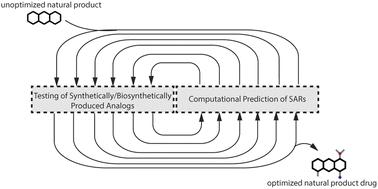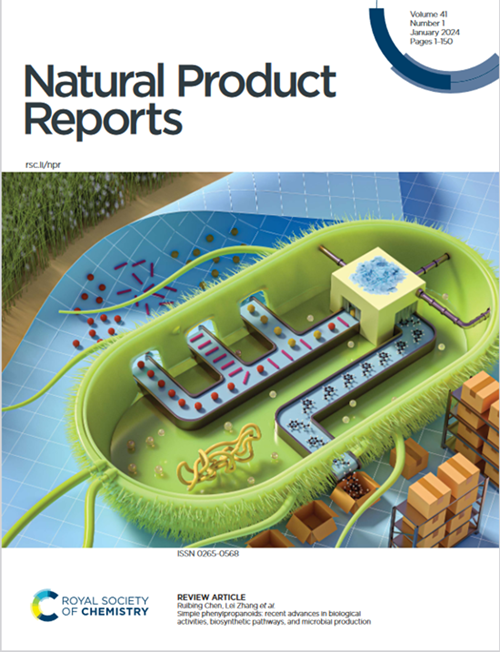Advances, opportunities, and challenges in methods for interrogating the structure activity relationships of natural products
IF 10.6
1区 化学
Q1 BIOCHEMISTRY & MOLECULAR BIOLOGY
引用次数: 0
Abstract
Time span in literature: 1985-early 2024
Natural products play a key role in drug discovery, both as a direct source of drugs and as a starting point for the development of synthetic compounds. Most natural products are not suitable to be used as drugs without further modification due to insufficient activity or poor pharmacokinetic properties. Choosing what modifications to make requires an understanding of the compound's structure–activity relationships. Use of structure–activity relationships is commonplace and essential in medicinal chemistry campaigns applied to human-designed synthetic compounds. Structure–activity relationships have also been used to improve the properties of natural products, but several challenges still limit these efforts. Here, we review methods for studying the structure–activity relationships of natural products and their limitations. Specifically, we will discuss how synthesis, including total synthesis, late-stage derivatization, chemoenzymatic synthetic pathways, and engineering and genome mining of biosynthetic pathways can be used to produce natural product analogs and discuss the challenges of each of these approaches. Finally, we will discuss computational methods including machine learning methods for analyzing the relationship between biosynthetic genes and product activity, computer aided drug design techniques, and interpretable artificial intelligence approaches towards elucidating structure–activity relationships from models trained to predict bioactivity from chemical structure. Our focus will be on these latter topics as their applications for natural products have not been extensively reviewed. We suggest that these methods are all complementary to each other, and that only collaborative efforts using a combination of these techniques will result in a full understanding of the structure–activity relationships of natural products.


天然产品结构活性关系研究方法的进展、机遇和挑战。
文献时间跨度:1985 年至 2024 年初天然产物在药物发现中发挥着关键作用,既是药物的直接来源,也是合成化合物开发的起点。由于活性不足或药代动力学特性不佳,大多数天然产物在未经进一步修饰的情况下不适合用作药物。选择进行何种改造需要了解化合物的结构-活性关系。在药物化学研究中,结构-活性关系的使用非常普遍,而且对人类设计的合成化合物至关重要。结构-活性关系也被用于改善天然产物的特性,但一些挑战仍然限制着这些努力。在此,我们将回顾研究天然产物结构-活性关系的方法及其局限性。具体来说,我们将讨论如何利用合成(包括全合成、后期衍生化、化学酶合成途径以及生物合成途径的工程和基因组挖掘)来生产天然产物类似物,并讨论每种方法所面临的挑战。最后,我们将讨论计算方法,包括用于分析生物合成基因与产品活性之间关系的机器学习方法、计算机辅助药物设计技术和可解释的人工智能方法,以便通过训练有素的模型阐明结构与活性之间的关系,从而根据化学结构预测生物活性。我们的重点将放在后几个主题上,因为它们在天然产品方面的应用尚未得到广泛的研究。我们认为,这些方法都是相辅相成的,只有结合使用这些技术,才能全面了解天然产品的结构-活性关系。
本文章由计算机程序翻译,如有差异,请以英文原文为准。
求助全文
约1分钟内获得全文
求助全文
来源期刊

Natural Product Reports
化学-生化与分子生物学
CiteScore
21.20
自引率
3.40%
发文量
127
审稿时长
1.7 months
期刊介绍:
Natural Product Reports (NPR) serves as a pivotal critical review journal propelling advancements in all facets of natural products research, encompassing isolation, structural and stereochemical determination, biosynthesis, biological activity, and synthesis.
With a broad scope, NPR extends its influence into the wider bioinorganic, bioorganic, and chemical biology communities. Covering areas such as enzymology, nucleic acids, genetics, chemical ecology, carbohydrates, primary and secondary metabolism, and analytical techniques, the journal provides insightful articles focusing on key developments shaping the field, rather than offering exhaustive overviews of all results.
NPR encourages authors to infuse their perspectives on developments, trends, and future directions, fostering a dynamic exchange of ideas within the natural products research community.
 求助内容:
求助内容: 应助结果提醒方式:
应助结果提醒方式:


